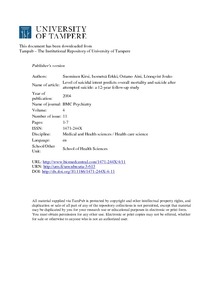Level of suicidal intent predicts overall mortality and suicide after attempted suicide: a 12-year follow-up study
Suominen, Kirsi; Isometsä, Erkki; Ostamo, Aini; Lönnqvist, Jouko (2004)
Suominen, Kirsi
Isometsä, Erkki
Ostamo, Aini
Lönnqvist, Jouko
2004
BMC Psychiatry 4
11
This publication is copyrighted. You may download, display and print it for Your own personal use. Commercial use is prohibited.
Julkaisun pysyvä osoite on
https://urn.fi/urn:nbn:uta-3-613
https://urn.fi/urn:nbn:uta-3-613
Kuvaus
BioMed Cental open access
Tiivistelmä
Background
The aim of this study was to comprehensively examine clinical risk factors, including suicide intent and hopelessness, for suicide and risk of death from all causes after attempted suicide over a 12-year follow-up period.
Methods
A systematic sample of 224 patients from consecutive cases of attempted suicide referred to health care in four Finnish cities between 1 January and 31 July 1990 was interviewed.
Results
After 12 years of follow-up 22% of these patients had died, 8% by committing suicide. The only statistically significant risk factor for eventual suicide was high scores on Beck's Suicidal Intention Scale. Male gender, older age, physical illness or disability and high scores on Beck's Suicidal Intention Scale predicted death overall.
Conclusions
Following attempted suicide, high intention to kill oneself is a significant risk factor for both death from all causes and suicide.
Keywords: attempted suicide; suicide; outcome; follow-up studies; risk factors; suicide intent; hopelessness
The aim of this study was to comprehensively examine clinical risk factors, including suicide intent and hopelessness, for suicide and risk of death from all causes after attempted suicide over a 12-year follow-up period.
Methods
A systematic sample of 224 patients from consecutive cases of attempted suicide referred to health care in four Finnish cities between 1 January and 31 July 1990 was interviewed.
Results
After 12 years of follow-up 22% of these patients had died, 8% by committing suicide. The only statistically significant risk factor for eventual suicide was high scores on Beck's Suicidal Intention Scale. Male gender, older age, physical illness or disability and high scores on Beck's Suicidal Intention Scale predicted death overall.
Conclusions
Following attempted suicide, high intention to kill oneself is a significant risk factor for both death from all causes and suicide.
Keywords: attempted suicide; suicide; outcome; follow-up studies; risk factors; suicide intent; hopelessness
Kokoelmat
- Artikkelit [6140]
